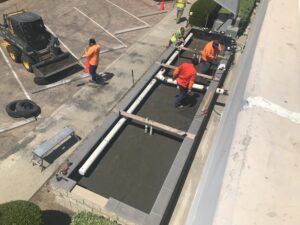Biofiltration BMPs found to remove microplastic particles

A two-year study examining whether biofiltration BMPs (best management practices) can efficiently remove microplastics from Southern California runoff has found that these stormwater control measures are effective as a treatment solution – an important finding given that runoff is a major contributor to microplastics pollution in aquatic environments.
The regional SCCWRP-led study, completed in October, provides encouraging news for water-quality managers across California and beyond that are seeking solutions to better control and manage the ubiquitous and growing problem of microplastics pollution. Researchers estimate that trillions of microplastic particles are discharged annually into California coastal waters via runoff, with much of it coming from vehicle tire-wear particles.
During the BMP microplastics study, researchers measured the levels of microplastics entering and exiting seven biofiltration BMPs during 18 rain events.
The study found that biofiltration BMPs successfully reduced microplastics concentrations by a median of 72% across all storm events. Moreover, the study found that the engineered media in biofiltration systems is uniformly efficient at microplastics removal, regardless of the measured size of microplastics and regardless of the type of media installed found in the existing BMPs.
The study also found that microplastic particles appear to be primarily removed upon becoming trapped within the pore spaces between engineered media particles. Thus, media pore size could be a useful design consideration for optimizing BMP performance in the future.
Biofiltration systems are a ubiquitous type of stormwater BMP that is designed to filter and trap sediment, nutrients, metals and other common contaminants as runoff passes through them. In recent years, as microplastics have emerged as a priority contaminant to manage in California’s aquatic ecosystems, researchers have begun exploring whether biofiltration systems also are effective at removing microplastics.

The BMP microplastics study was the first regional-scale microplastics investigation focused on biofiltration BMPs. To conduct the study, researchers leveraged the Southern California Stormwater Monitoring Coalition (SMC) Regional BMP Monitoring Network, which was recently established to study the effectiveness of structural BMPs in improving runoff water quality and quantity across Southern California.
The microplastics findings are the first of the BMP monitoring network’s data analyses to be completed; BMP performance evaluation findings for other stormwater contaminants are expected to be released in early 2026.
The BMP microplastics study represents a bright spot in California’s ongoing efforts to identify effective solutions for removing microplastics from aquatic environments. In 2022, California released a comprehensive microplastics management strategy that calls for an initial set of management actions to curb the spread of microplastics, plus focused research to identify future potential microplastics management solutions.
In response, SCCWRP and its partners have been investigating stormwater BMPs for their potential to remove microplastics from runoff. In addition to the biofiltration study, SCCWRP is working with the SMC on an ongoing study that will quantify the effectiveness of street sweeping – a type of non-structural BMP – in removing multiple types of stormwater contaminants, including microplastics.
Meanwhile, researchers hypothesize that other types of filtration-based BMPs, such as permeable pavement, may have microplastics removal capacity similar to biofiltration BMPs.
For more information, contact Dr. Elizabeth Fassman-Beck or Dr. Danhui Xin.
More news related to: Emerging Contaminants, Runoff Water Quality, Stormwater BMPs, Top News, Trash Pollution